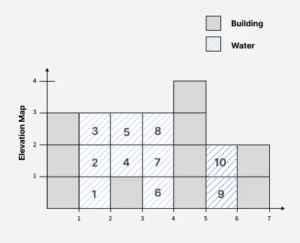Given an array arr[] with non-negative integers representing the height of blocks. If the width of each block is 1, compute how much water can be trapped between the blocks during the rainy season.
Examples:
Input: arr[] = [3, 0, 1, 0, 4, 0 2] Output: 10 Explanation: Total water trapped = 0 + 3 + 2 + 3 + 0 + 2 + 0 = 10 units.

Input: arr[] = [3, 0, 2, 0, 4] Output: 7 Explanation: Total water trapped = 0 + 3 + 1 + 3 + 0 = 7 units.
Input: arr[] = [1, 2, 3, 4] Output: 0 Explanation: We cannot trap water as there is no height bound on both sides.
Input: arr[] = [2, 1, 5, 3, 1, 0, 4] Output: 9 Explanation: Total water trapped = 0 + 1 + 0 + 1 + 3 + 4 + 0 = 9 units.
Constraints:
1 < arr.size() < 105
0 < arr[i] < 103
Approach 01:
-
C++
-
Python
#include <vector>
#include <algorithm>
using namespace std;
class Solution {
public:
int maxWater(vector<int> &heights) {
int totalWater = 0; // To store the total trapped water
int leftMax = 0, rightMax = 0; // Maximum heights from the left and right
int leftPointer = 0, rightPointer = heights.size() - 1; // Pointers to traverse the array
while (leftPointer < rightPointer) {
leftMax = max(leftMax, heights[leftPointer]); // Update left maximum
rightMax = max(rightMax, heights[rightPointer]); // Update right maximum
if (heights[leftPointer] <= heights[rightPointer]) {
totalWater += leftMax - heights[leftPointer]; // Add trapped water on the left side
leftPointer++;
} else {
totalWater += rightMax - heights[rightPointer]; // Add trapped water on the right side
rightPointer--;
}
}
return totalWater;
}
};
class Solution:
def maxWater(self, heights):
totalWater = 0 # To store the total trapped water
leftMax = 0 # Maximum height from the left
rightMax = 0 # Maximum height from the right
leftPointer = 0 # Pointer to traverse from the left
rightPointer = len(heights) - 1 # Pointer to traverse from the right
while leftPointer < rightPointer:
leftMax = max(leftMax, heights[leftPointer]) # Update left maximum
rightMax = max(rightMax, heights[rightPointer]) # Update right maximum
if heights[leftPointer] <= heights[rightPointer]:
totalWater += leftMax - heights[leftPointer] # Add trapped water on the left side
leftPointer += 1
else:
totalWater += rightMax - heights[rightPointer] # Add trapped water on the right side
rightPointer -= 1
return totalWater
Time Complexity:
- Single Pass:
The algorithm uses two pointers that traverse the array from both ends towards the center. Each element is processed at most once, resulting in \( O(n) \), where \( n \) is the size of the input array.
- Overall Time Complexity:
\( O(n) \).
Space Complexity:
- Constant Extra Space:
The algorithm uses a constant amount of extra space for variables like
leftMax,rightMax,leftPointer, andrightPointer, regardless of the input size. - Input Array:
The input array is read-only and does not require additional storage.
- Overall Space Complexity:
\( O(1) \).